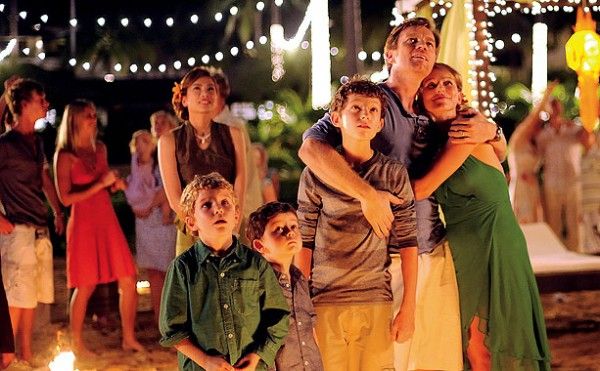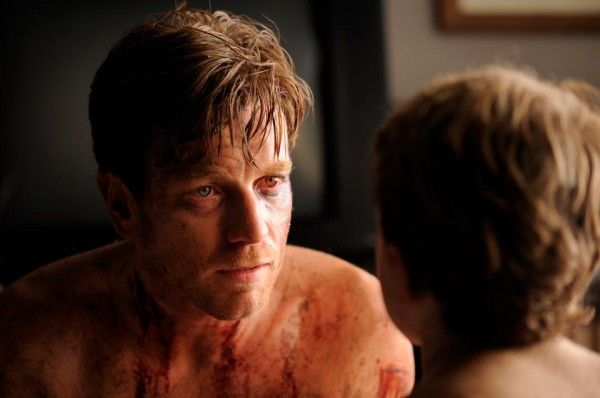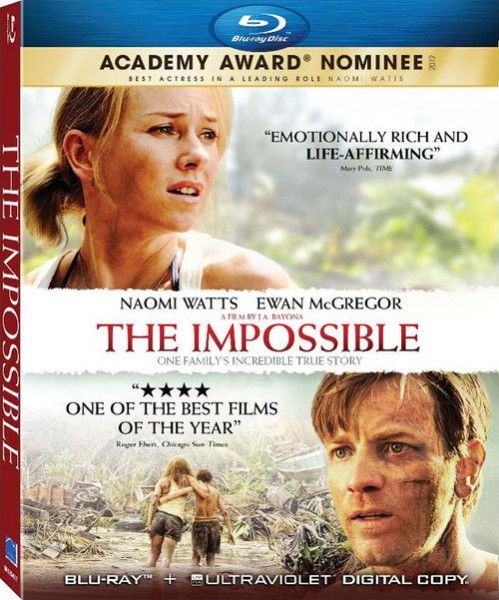The Impossible is a tricky film to write about because there’s just something inherently tricky about the film itself. Maybe that’s because it’s based on a true story that often feels a little too impossible to believe. Or maybe it’s because that story has been so blatantly Hollywood-ized – with Spanish 2004 Indian Ocean tsunami survivors María Belón Alvárez and Tomás Belón recast as the impossibly blonde-haired and blue-eyed Naomi Watts and Ewan McGregor. Or maybe it’s because the finished film falls into a Hollywood genre that typically encourages us to revel in the onscreen wreckage, only here it’s impossible to do so without feeling weird - I mean, over 200,000 people died as a result of that really cool-looking wave! Anyway, these were the issues I had when I first saw The Impossible and which resurfaced while watching it on Blu-ray. Hit the jump for my review.
But I don’t want to just send a giant wet tsunami blanket over the whole film, which certainly has its merits. For starters, the true story of the Belón-Alvárez family’s survival is a riveting one. On vacation in Khao Lak, Thailand, for Christmas holiday, María Belón Alvárez, Tomás Belón and their children were among the hundreds of thousands affected by the 2004 Indian Ocean tsunami. In the film simulacrum of events, María is Maria, a British physician-turned-housewife, played by Naomi Watts, and Tomás is now Scottish businessman Henry, played by Ewan McGregor. In the film’s opening moments, we are introduced to these loving spouses and their three sons as they spend Christmas Day in Thai paradise. Then the shit – or water - hits the fan.
I have to admit; the tsunami sequence that follows is one of the most intense ten minutes I’ve ever seen on film. Spanish director Juan Antonio Bayona (The Orphanage) manages to out-Emmerich Roland Emmerich with disaster footage that actually looks and feels breathtakingly real. Forget the CGI bullshit of 2012 - here you actually feel like you are with Watts as she struggles to stay alive in a torrent of ocean water ravaged with debris. Once this sequence ends, the story and filmmaking settle into a calmer, more conventional mode as Maria and eldest son Lucas (newcomer Tom Holland) seek refuge in a local hospital, while Henry and his two younger sons search for them across a landscape that’s been instantly transformed from paradise into water-logged hell.
I hope I’m not giving too much away by revealing that the entire Belón Alvárez family survived the tsunami. I mean, it’s pretty apparent in the film’s trailer or via a quick Google search. And while this is a wonderful truth for the real-life Belón Alvárez family, it does not make for great cinematic drama. With its sole focus on the white, surviving Belón Alvárez family, viewers don’t even come close to experiencing the truly epic loss of native life that occurred that day in Khao Lak. Frankly, for narrative and realism purposes, a major character should have died – they certainly did in real life.
Oddly enough, the film would have been stronger if it had taken a page from the Roland Emmerich disaster movie playbook. Say what you want about the quality of Emmerich’s films but they certainly have quantity: of effects, explosions and, most importantly, characters. By tracking multiple character groupings as they face catastrophic earthquakes and alien attacks, his movies usually offer a more balanced portrayal of life and death in the face of natural and unnatural disaster. Here, we just track one group of survivors, although Watts, McGregor and young actor Tom Holland effectively inhabit the fear and trauma their underwritten characters endure.
At this point, I think it’s worth noting The Impossible’s failure at the U.S. box office, where it grossed a paltry $19 Million. I remember being a bit surprised by that poor performance, considering the fact that American audiences bought tickets in droves to see the craptastic Deep Impact, which sold itself on the simple image of a giant tsunami wave crashing over Manhattan. Maybe if Summit had released a trailer featuring more wreckage and less “inspirational drama” stuff, it would have been a bigger hit. Instead, the studio seemed intent on positioning The Impossible as an awards season contender, where it came up empty-handed, save an Oscar nod for Watts. Those hands probably would have been full of cash if the studio had just sold it as an Emmerich-style disaster film. But at its sweet and earnest heart, that’s not what The Impossible is. And that’s what makes it such a tricky film.
EXTRAS
Extras on the disc include a group commentary with director J.A. Bayona, writer Sergio G. Sánchez, producer Belén Atienza, and Maria Belón, the inspiration for Watts’ character. Highlights include Belón’s personal anecdotes about the real life events of December 26, 2004 and director Bayona discussing the reasons why he decided to make her family’s story more universal by casting Naomi and Ewan.
Additional bonus materials include "Casting The Impossible," in which cast members takes turns praising each other, and the more informative featurette, "Realizing The Impossible,” in which the filmmakers reveal how a tighter budget forced them to use practical effects in creating the tsunami footage. This last featurette should be mandatory viewing for all of Hollywood’s overly CGI-dependent filmmakers!
In addition, there are five deleted scenes and the film’s original theatrical trailer, which I still think gives too much away.
PICTURE/SOUND
The Impossible is presented in 1080p High Definition 2:35:1 picture, while audio options on the Blu-ray disc include English DTS-HD Master Audio 5.1 and Spanish DTS-HD Master Audio 5.1. The striking clarity of the images and the comprehensive texture of the sound lend the film an incredible, you-are-there urgency, especially during the tsunami sequence.
FINAL THOUGHTS
A disaster drama that, while well-made and acted, fails as typical disaster movie entertainment because it doesn’t allow you the cheap thrills usually associated with the genre, and fails as truly devastating drama because it doesn’t fully capture the epic loss of human life caused by the 2004 Indian Ocean tsunami.
The Impossible is rated PG-13 for intense realistic disaster sequences, including disturbing injury images and brief nudity. It has a run time of 114 minutes.




